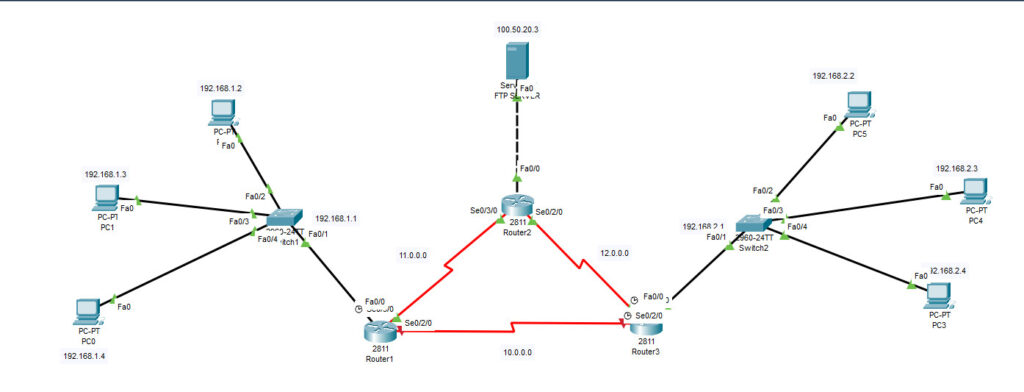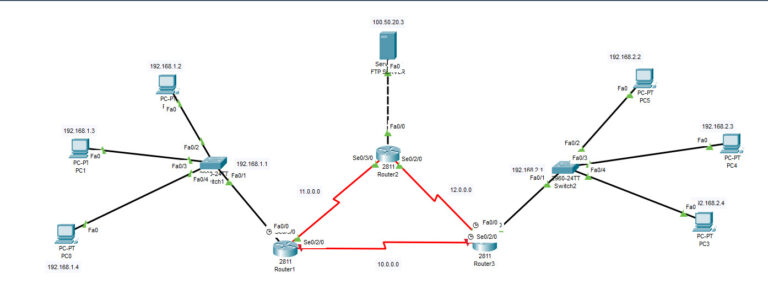Introduction
In today’s digital age, robust and reliable network infrastructure is the backbone of any modern enterprise. Whether it’s enabling seamless communication across departments, providing secure access to resources, or ensuring the efficient operation of critical business applications, the design and implementation of network topologies have become a key aspect of organizational success. This project is a simulation of an advanced network topology designed to meet the needs of a growing enterprise, ensuring secure and efficient communication between various departments and locations.
Project Overview
This project presents a simulated network topology created using Cisco Packet Tracer. The topology is carefully designed to represent a scalable and secure network architecture that can be used by medium to large enterprises. The simulation features multiple subnetworks connected through routers, switches, and a centralized FTP server that provides file-sharing capabilities across the entire network.
Network Components and Design
Subnetworks:
The network is divided into three primary subnets, each representing different organizational departments:
- Subnet 1 (192.168.1.0/24): Represents the HR department, equipped with PCs (PC0, PC1, PC2) connected through a switch (Switch1).
- Subnet 2 (192.168.2.0/24): Represents the IT department, equipped with PCs (PC3, PC4, PC5) connected through another switch (Switch2).
- Subnet 3 (10.0.0.0/24, 11.0.0.0/24, 12.0.0.0/24): Represents the core network infrastructure where routing and FTP services are managed.
2. Routers
Router1, Router2, and Router3 form the backbone of the network, facilitating communication between different subnets. Each router is configured with specific routes to ensure data packets are directed efficiently across the network.
3. FTP Server:
The centralized FTP Server (100.50.20.3) is critical for the organization, enabling secure file sharing and storage across all departments. The server is connected directly to Router2, ensuring high availability and fast access times.
4. Redundant Links:
Redundant links between the routers are implemented to ensure high availability and reliability. If one link fails, traffic can still be routed through an alternative path, minimizing downtime and ensuring business continuity.

Why This Project Matters
In the fast-paced business world, downtime or data breaches can be catastrophic. This network design addresses these challenges by ensuring:
- Scalability: The network can easily grow as the organization expands, with the ability to add more subnets or devices without significant reconfiguration.
- Security: Segmentation of the network into subnets helps contain security breaches, while the central FTP server ensures that sensitive data is stored securely.
- Efficiency: Optimized routing ensures that data packets are delivered quickly and reliably, reducing latency and improving overall network performance.
- Reliability: The use of redundant links minimizes the risk of network failure, providing consistent access to critical resources.
Conclusion
This project showcases a well-rounded, scalable, and secure network topology that is suitable for enterprises looking to enhance their network infrastructure. By simulating this topology, network administrators and IT professionals can gain valuable insights into how to design, implement, and manage enterprise networks that meet the demands of today’s business environment.

Latest blog
Follow me on




